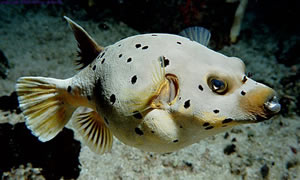Archive Site Provided for Historical Purposes

Sponsored by the U.S. Department of Energy Human Genome Program
In this issue...
Available in PDF
In the News
Comparative Genomics
Mouse
Web, Publications, Resources
Funding
Meeting Calendars & Acronyms

Scientists searching human genome data for genes and the DNA sequences that control their activity soon will have a valuable new resource, courtesy of the Japanese delicacy known as Fugu (Fugu rubripes) or pufferfish. An international consortium, led by researchers at the DOE Joint Genome Institute (JGI), has announced a collaborative agreement to sequence the Fugu genome.
Although the Fugu genome contains essentially the same genes and regulatory sequences as the human, it comprises only about 400 million bases as compared with the 3.2 billion bases that make up human DNA. With far less noncoding (sometimes known as "junk") DNA to sort through, identifying biologically important regions in the Fugu genome should be a much easier task. Comparing such DNA sequences from different species is an effective method because evolution tends to conserve these regions. JGI is generating draft sequences for the Fugu genome project and applying Jazz, a new sequence assembler written at JGI.
Sequence finishing and computational annotation are being done with other consortium members: U.K. Human Genome Mapping Project; Institute of Molecular and Cell Biology, Singapore; Molecular Sciences Institute, Berkeley; and Institute for Systems Biology, Seattle.
Pufferfish are raised in bulk on farms in Japan, where the taste is considered addictive. If prepared improperly, however, the flesh can be lethal due to a highly potent neurotoxin present in Fugu ovaries, intestines, and livers. Eating pufferfish claims the lives of about 70 to 100 adventuresome (or unsuspecting) diners each year, most in rural areas and from fish improperly cleaned at home. It is the only food forbidden to be served to Japan's royal family.
Fugu's deadly effects have caught the imagination of many authors, including Ian Fleming. Near the end of From Russia with Love, the fictional James Bond is almost killed by Fugu toxin.
The electronic form of the newsletter may be cited in the following style:
Human Genome Program, U.S. Department of Energy, Human Genome News (v11n3-4).
The Human Genome Project (HGP) was an international 13-year effort, 1990 to 2003. Primary goals were to discover the complete set of human genes and make them accessible for further biological study, and determine the complete sequence of DNA bases in the human genome. See Timeline for more HGP history.
Published from 1989 until 2002, this newsletter facilitated HGP communication, helped prevent duplication of research effort, and informed persons interested in genome research.